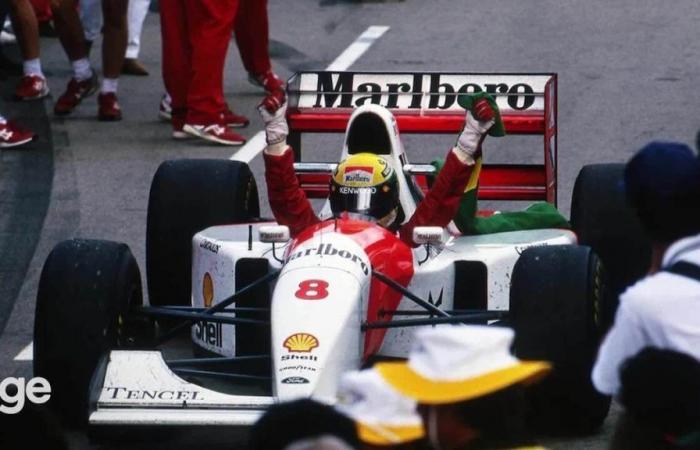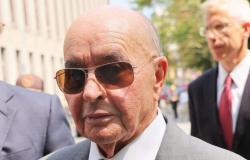With the best car on the grid or with slower ones, Ayrton Senna always pushed teams to the limit on the Formula 1 tracks. In ten years in the category, the driver played for Toleman, Lotus, McLaren and Williams. O ge shows all the machines driven by the Brazilian idol in the 162 races contested in F1.
Who was Ayrton Senna, the last Brazilian three-time F1 champion?
The first car used by Ayrton Senna in Formula 1 was far from being one of the best on the grid. The Toleman TG183B had been used since the end of the 1982 season and, together with the Hart engine, was far behind the other cars. Even so, the Brazilian managed to push the machine beyond its limit. Senna’s performance in the four races in which he used the car was a mix of frustration and joy.
On his debut, he had to abandon in Jacarepaguá. In the very next race, at the South African GP, the euphoria for the first point achieved with a sixth place was contained by a fainting spell at the end of the race. Dehydrated, Ayrton took Toleman-Hart beyond his physical limit. Two weeks later, in Belgium, the Brazilian finished sixth again and scored points. The machine was “retired” after abandoning it at the San Marino GP, when Senna did not qualify.
Toleman’s new car could have debuted at Imola, but the team preferred to postpone the launch due to problems with Pirelli, which angered Senna. At the Dijon track, in France, he was satisfied with the potential of the TG184, which maintained a good pace in training and in qualifying, but had to abandon it due to a breakdown in the Hart engine.
Everything would improve afterwards, in Monaco. After starting 13th, Senna advanced despite heavy rain and overtook Niki Lauda, who would be champion in 1984. Alain Prost was the leader, and was overtaken by Toleman at the checkered flag, but the race had been stopped beforehand. In the end, Ayrton achieved the first podium of his career and took second place. This was the first of three podiums achieved by the Brazilian rookie that year. Two others would come in third place at Silverstone, in England, and Estoril, in Portugal.
Although he achieved great results, not everything was just flowers for Ayrton Senna. He managed to finish only six of the 14 races he competed in in 1984. With that, he looked for new directions for the following year, and agreed with Lotus, owner of the 97T, a competitive car, but not as reliable.
With yet another retirement on his debut (the first of seven that season), Senna took the 97T to the top in the second stage, at the Portuguese GP. He flew on the track to win his first victory in Formula 1 with a wide gap to his opponents. The black and gold Lotus car competed head to head with McLaren, Ferrari and Williams, but had reliability problems with the Renault engine. Still, Ayrton achieved three more podiums and won another victory, this time at the Belgian GP.
Lotus’ power continued into 1986 in the 98T, which featured great results from Ayrton Senna to fight for that year’s world title. The Brazilian won two victories in the Spanish and Detroit GPs, in the USA, and reached the podium on five other occasions.
Although it was powerful, the 98T did not maintain the consistency to fight with the McLaren of Alain Prost and the Williams of Nelson Piquet and Nigel Mansell, the three drivers who finished ahead of Senna in the Formula 1 classification in 1986. This was the last year of the partnership between Lotus and Renault on the team’s engines.
In addition to changing engines from Renault to Honda, Lotus also changed the paintwork. Sponsored by Camel, the car was predominantly yellow with blue details. With chassis and aerodynamic problems, the 99T left something to be desired in relation to Piquet and Mansell’s Williams-Renault.
None of this stopped Ayrton Senna from impressing on the track. Third place in 1987, he achieved two victories that year: the first in Monaco and another in Detroit. In addition, there were six more podiums to get ahead of McLaren’s Alain Prost for the first time in his career.
In pursuit of the title, Senna signed with McLaren for 1988. The MP4/4 had Honda’s heavy turbo engine, so the low chassis was made for aerodynamics on the straights. The result was a car left over from the season driven by the two best Formula 1 drivers at the time.
The dominance was clear from the start. In the first year of competition between Prost and Senna, the fight for the championship was race by race. McLaren won 15 of the 16 races that season, seven with the Frenchman and eight with the Brazilian, champion for the first time in 1988.
The dispute between Senna and Prost continued in 1989 in another dominant McLaren car, the MP4/5, which had the previous model as a base. The end of the turbo engine brought the arrival of the naturally aspirated V10. The team’s pace was the best on the grid and gave Williams and Ferrari no chance.
The 1989 title was decided at the Japanese GP after a controversial disqualification by Senna in a crash with Prost, who became champion despite having two fewer victories than his teammate. Ayrton reached the podium on seven occasions during the season, only one of them outside the highest place.
In 1990, the wings and rear bodywork were redesigned for larger radiators, and Senna participated in many tests to improve the reliability of the Honda engine. The McLaren MP4/5B showed an intense pace in qualifying, which featured many pole positions for the Brazilian.
Alain Prost would get in Ayrton Senna’s way once again, now at the wheel of the Ferrari 641, which fought with McLaren in the races. For the third consecutive year, the Japanese GP decided the championship. The rivals collided in the first corner of the race and the world title went to the Brazilian for the second time. Senna achieved six victories and eleven podiums in 1990.
McLaren remained at the top for 1991, when the MP4/6 arrived with Honda’s V12 engine. While Senna still demanded improvements in the machine, he started the season with four consecutive victories to take advantage of the low performance of the Williams FW14, which arrived with strength in the second half of the year.
This was the last car with manual transmission to win Formula 1. It was in 1991 that Senna won the famous victory in the Brazilian GP stuck in sixth gear. Physically exhausted, Ayrton starred in one of the most emotional scenes in the history of the category on the Interlagos podium. Three-time world champion that year, he scored seven victories and twelve podiums with the MP4/6.
McLaren-Honda’s reign came to an end in 1992, with the beginning of Williams-Renault’s dominance and cars “from another planet”, as Ayrton Senna said. The year started with the MP4/6B, a variant from the previous season that only lasted two races and gave the Brazilian a third place.
Even with three victories this year, Senna was behind not only the two Williams drivers, but also Michael Schumacher’s Benetton. The active suspension in Mansell and Patrese’s car left McLaren far from matching what its opponents presented throughout 1992.
Senna’s magic was shown in the years when McLaren was far from equaling the power of Williams-Renault, as well as in 1993. The joining of the opposing team with rival Alain Prost made life even more difficult for the Brazilian idol, who had incredible victories and exciting songs on MP4/8.
Ford’s V8 engine was far from being one of the most powerful on the grid, but Senna took the machine to five victories that year, including his last in Formula 1. The 1993 title went to Alain Prost, and the Brazilian was runner-up. champion in farewell to McLaren.
Senna was finally able to fulfill his desire to drive the Williams car, the first one he tested before entering Formula 1, back in 1983. With the FW16 model, Ayrton had hopes of becoming champion with the team that had won the last two seasons. of the category. None of this would work.
Due to changes in regulations, the FW16 had several changes compared to models from previous years, and presented severe drivability problems. Senna abandoned the first two races, in the Brazilian and Pacific GPs. In the third, in Ímola, the Brazilian idol crashed hard at the Tamburello curve and died at the age of 34.






